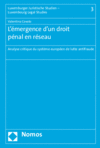Zusammenfassung
Wie kann ein europäisches Strafrecht begründet werden? Die Studie argumentiert mithilfe einer Analyse der Instrumente zur Betrugsbekämpfung, dass eine neue soziale Kontrolle auf dem Vormarsch ist: Bis zum heutigen Zeitpunkt stützt sich die Untersuchung und Verfolgung von Betrug am europäischen Haushalt auf die Kooperation eines Netzwerks nationaler und übernationaler Stellen, deren Arbeit von jeweils unterschiedlichen Rechtssystemen bestimmt wird. Die in diesem Netzwerk-Strafrecht entstehenden Fragen können weder durch nationale Alleingänge noch durch die gemeinschaftliche Vorgehensweise beantwortet werden.
Die Studie bietet einen Ausweg, indem sie mithilfe eines multidisziplinären Ansatzes ein alternatives Modell zur Legitimierung vorschlägt. Dieses Modell erlaubt eine umfassende Evaluierung des Europäischen Amts für Betrugsbekämpfung (OLAF), eine detaillierte Analyse der durch die EU-Richtlinie 883/2013 etablierten Verfahrensbedingungen und des institutionellen Aspekts im Hinblick auf die Einrichtung einer Europäischen Staatsanwaltschaft.
Résumé
How to build a European penal system? Through the analysis of anti-fraud instruments, the study argues that new structures of social control are emerging: within the European Union, investigation and prosecution of fraud rely on the cooperation among a network of national and supranational authorities that are governed by distinct and autonomous legal systems. Thus defined, the network criminal law raises questions that neither national sovereignty nor the community method can answer. By adopting a multidisciplinary approach, ways forward are explored by developing an alternative model of legitimization. The latter enables a comprehensive evaluation of the European Anti-fraud Office (OLAF), including a detailed analysis of the procedural framework established by regulation 883/2013 as well as institutional aspects in the light of the setting up of a European Public Prosecutor Office.
- 35–82 Introduction 35–82
- 219–220 Hypothèse de travail 219–220
- 753–764 Conclusion générale 753–764
- 765–836 Bibliographie 765–836
- 837–840 Index 837–840

